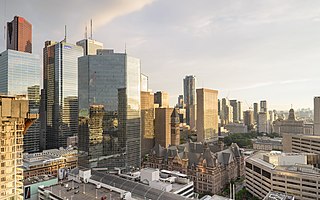
CT Financial Services Inc., operating as Canada Trust, was a financial services holding company headquartered in Toronto, Ontario, which operated in Canada through its trust company subsidiaries, including Canada Trustco Mortgage Company and The Canada Trust Company.

Toronto-Dominion Bank, doing business as TD Bank Group, is a Canadian multinational banking and financial services corporation headquartered in Toronto, Ontario. The bank was created on February 1, 1955, through the merger of the Bank of Toronto and The Dominion Bank, which were founded in 1855 and 1869; respectively. It is one of two Big Five banks of Canada founded in Toronto, the other being the Canadian Imperial Bank of Commerce. The TD Bank SWIFT code is TDOMCATTTOR and the TD institution number is 004.

Bay Street is a major thoroughfare in Downtown Toronto, Ontario, Canada. It is the centre of Toronto's Financial District and is often used by metonymy to refer to Canada's financial services industry since succeeding Montreal's St. James Street in that role in the 1970s.

Royal Bank of Canada is a Canadian multinational financial services company and the largest bank in Canada by market capitalization. The bank serves over 17 million clients and has more than 89,000 employees worldwide. Founded in 1864 in Halifax, Nova Scotia, it maintains its corporate headquarters in Toronto and its head office in Montreal. RBC's institution number is 003. In November 2017, RBC was added to the Financial Stability Board's list of global systemically important banks.
Big Five is the name colloquially given to the five largest banks that dominate the banking industry of Canada: Bank of Montreal (BMO), Bank of Nova Scotia (Scotiabank), Canadian Imperial Bank of Commerce (CIBC), Royal Bank of Canada (RBC), and Toronto-Dominion Bank (TD).
A trust company is a corporation that acts as a fiduciary, trustee or agent of trusts and agencies. A professional trust company may be independently owned or owned by, for example, a bank or a law firm, and which specializes in being a trustee of various kinds of trusts.

Place Ville Marie is a large office and shopping complex skyscraper in Downtown Montreal, Quebec, Canada, comprising four office buildings and an underground shopping plaza. The main building, 1 Place Ville Marie, was built in the International style in 1962 as the headquarters for the Royal Bank of Canada. While RBC's corporate headquarters and the majority of its management operations have been based in Toronto's Royal Bank Plaza since 1976, Place Ville Marie remains RBC's head office, a distinct title from its corporate headquarters. It is a 188 m (617 ft), 47-storey, cruciform office tower. The complex is a nexus for Montreal's Underground City, the world's busiest, with indoor access to over 1,600 businesses, numerous subway stations, a suburban transportation terminal, and tunnels extending throughout downtown. A counter-clockwise rotating beacon on the rooftop lights up at night, illuminating the surrounding sky with up to four white horizontal beams that can be seen as far as 50 kilometres (31 mi) away. This beacon is not considered as a NAVAID for aviation purposes.

Olympia & York was a major international property development firm based in Toronto, Canada. The firm built major financial office complexes including Canary Wharf in London, the World Financial Center in New York City, and First Canadian Place in Toronto. It went bankrupt in the early 1990s and was recreated to eventually become Olympia & York Properties.

1000 de la Gauchetière is a skyscraper in Montreal, Quebec, Canada. It is named for its address at 1000 De la Gauchetière Street West in the downtown core. It is Montreal's tallest building as per the Council on Tall Buildings and Urban Habitat most widely used height definition for building height, which excludes antennas. It rises to the maximum elevation approved by the city at 232.5m above mean sea level with a total height from the street to roof of 205m (673ft) and 51 floors. A popular feature of the building is its atrium, which holds a large ice skating rink. The building was not subject to the 1992 municipal maximum height of 200m because it was finished in 1992.

The Fairmont Royal York, formerly and still commonly known as the Royal York, is a large historic luxury hotel in Toronto, Ontario, Canada. Located along Front Street West, the hotel is situated at the southern end of the Financial District, in Downtown Toronto. The Royal York was designed by Ross and Macdonald, in association with Sproatt and Rolph, and built by the Canadian Pacific Railway company. The hotel is currently managed by Fairmont Hotels and Resorts.

Saint Jacques Street, or St. James Street, is a major street in Montreal, Quebec, Canada, running from Old Montreal westward to Lachine.

BMO Bank, N.A. is an American national bank that is headquartered in Chicago, Illinois. It is the U.S. subsidiary of the Toronto-based multinational investment bank and financial services company Bank of Montreal, which owns it through the holding company BMO Financial Corporation. In September 2023, it was the 8th largest bank in the United States by total assets.

The economy of Toronto is the largest contributor to the Canadian economy, at 20% of the national GDP, and an important economic hub of the world. Toronto is a commercial, distribution, financial and industrial centre. It is Canada's banking and stock exchange centre and is the country's primary wholesale and distribution point. Ontario's wealth of raw materials and hydroelectric power have made Toronto a primary centre of industry. The metropolitan area of Greater Toronto produces more than half of Canada's manufactured goods. The economy of Toronto has had a GDP growth rate of 2.4 percent annually since 2009, outpacing the national average. Toronto's population was 3.025 million people as of 2022, while the population of the Toronto census metropolitan area was 6.47 million during the same year.

Royal LePage is a Canadian real estate franchiser and owner-operator with more than 670 locations and over 20,000 REALTORS® in Canada. The company was founded on July 2, 1913 in Toronto, Canada by then 26-year-old Albert Edward (A.E.) LePage, under the name "A.E. LePage, Bungalow Specialist." In 1984, the company was renamed Royal LePage Real Estate Services following a merger with Royal Trust's real estate brokerage business.

Banking in Canada is one of Canada's most important industries with several banks being among its largest and most profitable companies.
RBC Dominion Securities was the brand used by Royal Bank of Canada for full service brokerage services, primarily in Canada, and formed part of RBC's Wealth Management and Capital Markets divisions. Today, RBC Dominion Securities is known as RBC Capital Markets and RBC Wealth Management.

The Financial District is the central business district of Downtown Toronto, Ontario, Canada. It was originally planned as New Town in 1796 as an extension of the Town of York. It is the main financial district in Toronto and is considered the heart of Canada's finance industry. It is bounded roughly by Queen Street West to the north, Yonge Street to the east, Front Street to the south, and University Avenue to the west, though many office towers in the downtown core have been and are being constructed outside this area, which will extend the general boundaries. Examples of this trend are the Telus Harbour, RBC Centre, and CIBC Square.
Bertram Earl Jones is a Canadian unlicensed investment adviser who pleaded guilty to running a Ponzi scheme that CBC News has reported cost his victims "a conservative estimate of about $51.3 million taken between 1982 and 2009". After pleading guilty to two charges of fraud in 2010, he was sentenced to 11 years in prison. After serving four years of his sentence, Jones was released on March 20, 2014.
Edper Investments Ltd. was the primary holding company and investment vehicle for brothers Edward Bronfman and Peter Bronfman between 1959 and 1995. At its peak in the 1980s, and early 1990s, Edper was one of the largest corporate conglomerates in Canada, controlling more than 500 private and publicly traded companies in a complex structure that was estimated to be worth $100 billion, employed more than 100,000 Canadians, and comprised 15% of the total capitalization of the Toronto Stock Exchange.

First Capital REIT is a Canadian public real estate company, specializing in retail real estate, and based in Toronto, Ontario. It is one of the largest retail landlords in Canada.















